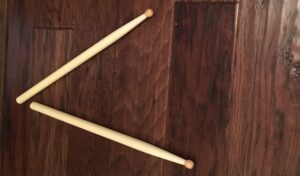This page has been updated. Please click here to view the new version or go to: https://www.rudimentaluniversity.com/auldlangsyne/
Month: December 2016
Drum Set Exercise: Triplet Limb Independence #2
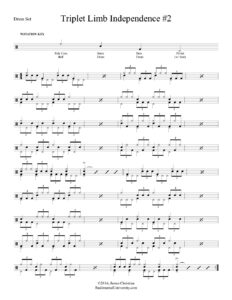
It’s coordination time again! In our last drum set exercise, we focused on different limb combinations with triplets. This week, we take the same concept further and increase the coordinative complexity a bit. (Note: This assumes a traditional kit setup, in which the ride cymbal and bass drum are played with the right hand and right foot respectively, and the snare drum and hi-hat are played with the left hand and left foot respectively. Adjust this exercise to work the same concepts according to your setup.)
Measures 1-2: triplets in left hand and left foot (3 notes each), quarter notes in right hand and right foot (lead with hand)
Measures 3-4: triplets in right hand and right foot (3 notes each), quarter notes in left hand and left foot (lead with hand)
Measures 5-6: triplets in left hand and left foot (3 notes each), quarter notes in right foot and right hand (lead with foot)
Measures 7-8: triplets in right hand and right foot (3 notes each), quarter notes in left foot and left hand (lead with foot)
Measures 9-12: repeats the previous patterns of measures 1-4 with triplets alternating single strokes between limbs
Measures 13-16: repeats measures 9-12, except the order of hand and foot is reversed on the single stroke triplets
Measures 17-18: a “tag” ending to wrap it up
Measures 19-36: the entire exercise repeats with the opposite side leading (right hand becomes left hand and vice versa, right foot becomes left foot and vice versa)
Between this exercise and the previous exercise, just about every combination is covered. If you can play both exercises smoothly and consistently, your coordination will increase significantly.
Snare Exercises: Three Flam Exercises
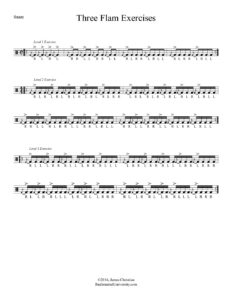
Three levels of snare exercises are presented here:
The first level focuses on basic flam rudiments—the flam, the flam tap, and the flam paradiddle. It’s a great exercise for younger players. Use the single flams to focus on great flam spacing, then utilize the same foundational motion to lead into the flam taps. (A flam and flam tap are very similar; simply add an extra note after the initial flam.) The transition between flam paradiddles is the same as the double in a flam tap, so each of the three rudiments build off of each other. The exercise is written in cut time to emphasize that it can be taken in a faster “two” feel once you feel comfortable with it. For young players, however, it would be better to start it in a slow 4/4. Once this exercise is solid, you can move on to the second level.
The second level exercise also utilizes flam taps and paradiddles, but flam accents are heavily incorporated in the first two measures. These three rudiments are the most common flam rudiments, and being able to play patterns like this is an important skill to achieve for any snare drummer or percussionist. (Note: This second exercise is not original with me. I played it regularly in my high school drum line under the instruction of Rick Beckham. It’s a really good exercise though, and it’s worth passing along.)
The third level exercise follows the same accent pattern as the previous exercise, but the coordinative complexity is increased. All of the flam rudiments are inverted lead-hand switch patterns. The flam taps are now inverted flam taps. The other patterns don’t have names that are universally agreed upon, but I like calling them inverted flam accents and inverted flam fours.
All of these exercises are good tests of flam coordination. As you practice them, always keep the grace notes low and close to the drum head. Make a distinction between accented and non-accented notes. As always, make sure your flams are consistent with proper spacing.
Happy flamming!
Holiday Percussion: World Percussion Christmas (Andrea Centazzo)
And now for something completely different…
Here is a playlist Andrea Centazzo’s World Percussion Christmas. All 10 tracks are arranged in different styles with different world percussion instruments. (I particularly like the rainy “O Holy Night” and the taiko-style arrangement of “The Little Drummer Boy.”) Enjoy!
Merry Christmas and Happy Holidays from Rudimental University!
https://www.youtube.com/playlist?list=PL-lleu9Z7yitJ-ojd6jnMzL8eAZ5N-jsv
Holiday Percussion: Christmas Bells, Mallets, & Drums (University of Oklahoma)
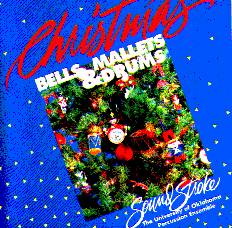 I got a CD of the University of Oklahoma Percussion Ensemble several years ago, and it is one of my favorite Christmas albums of all time. I believe it has a lot of mass appeal; it should be of interest to an audience of more than just percussionists. The all-percussion arrangements of different Christmas carols are excellent. Each arrangement is unique and original while always retaining a certain level of sophistication. The album strikes the perfect balance between interestingly energetic and calming background music.
I got a CD of the University of Oklahoma Percussion Ensemble several years ago, and it is one of my favorite Christmas albums of all time. I believe it has a lot of mass appeal; it should be of interest to an audience of more than just percussionists. The all-percussion arrangements of different Christmas carols are excellent. Each arrangement is unique and original while always retaining a certain level of sophistication. The album strikes the perfect balance between interestingly energetic and calming background music.
I cannot find a site that currently sells the CD (please leave a note in the comments section if you know of one). However, OU Percussion Press has sound files of every track available on their website: http://oupercussionpress.squarespace.com/catalog/ Just scroll down about two-thirds of the way until you see a section entitled “The Christmas Series.” All of the tracks are listed in order. Even better, you can purchase the full score and parts on their site to perform with your group. (I have performed two of them with a high school group in the past, and they were a lot of fun!)
Here is the track list:
- I Saw Three Ships
- Away in the Manger
- Christmas Medley (Joy to the World/ God Rest Ye Merry, Gentlemen/ O Little Town of Bethlehem/ What Child Is This?)
- O Green and Shimmering Tree
- Fum, Fum, Fum!
- Marimba Carol Medley
- The Christmas Song
- The Twelve Days of Christmas
- O Holy Night
- Carol of the Bells
- We Wish You a Merry Christmas
- Silent Night
- Deck the Halls
Holiday Percussion: “The Twelve Days of Christmas” (Kaboom Percussion)
Once again, we are celebrating the holidays this week by featuring percussion arrangements of Christmas music. Today’s unique arrangement, entitled “The 12 Cups of Christmas,” features Catherine Hall and Joshua Webster of Kaboom Percussion.
Holiday Percussion: “The Nutcracker” & “Frosty the Snowman” (University of North Texas)
All this week, we are featuring percussion arrangements of Christmas and holiday music. These two performances by the drum line and percussion ensembles at the University of North Texas are from a December 2016 concert. Enjoy music from “The Nutcracker” and “Frosty the Snowman.”
Holiday Percussion: “Pat a Pan” (Belmont Percussion Ensemble)
Many of you have time off from your normal schedule during this holiday season, and it’s a great time for practicing. If you need some material, there are quite a few exercises already posted on Rudimental University. This week, however, we’re going to take a break from the usual exercises and articles and just enjoy some percussion performances found on the Web. Today’s featured performance is the Belmont Percussion Ensemble’s unique twist on an arrangement of a Christmas classic entitled Patapan.
The original published version, which is a bit different from this recording, can be found on Row-Loff Percussion’s website: http://www.rowloff.com/search/description.html?item=08CS6
What to Do When You Don’t Feel Like Practicing
When I was a freshman in high school, I told my drum line instructor, “I didn’t practice this week. I just didn’t feel like practicing.” He replied, “What do you mean you didn’t feel like practicing!? The only way to get better is to practice when you don’t feel like it!”
What Does It Mean “to Feel”?
My instructor’s mini-beratement led to an important shift in my thinking. As I looked around the world, he was obviously correct. If you examine the top experts in any field—whether music, sports, science, business, literature, or anything else—those who reach the top must Read more “What to Do When You Don’t Feel Like Practicing”
Bass Drum Splitting Exercise: Triplet Split Patterns
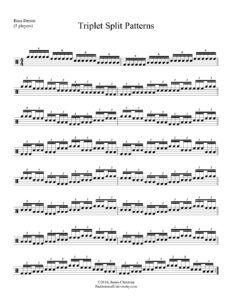
To view the exercise, click on the image to enlarge or click here to download in PDF format.
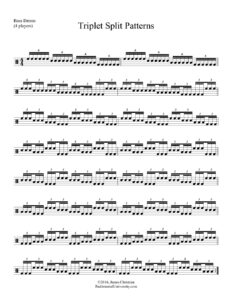
To view the exercise, click on the image to enlarge or click here to download in PDF format.
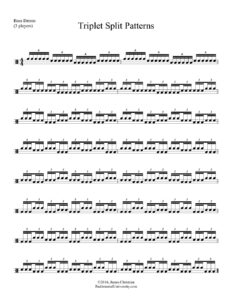
To view the exercise, click on the image to enlarge or click here to download in PDF format.
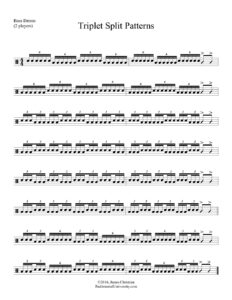
To view the exercise, click on the image to enlarge or click here to download in PDF format.
This exercise has been tailored for different bass line sizes—2 players, 3 players, 4 players, or 5 players. (If you have a larger bass line, simply take the version for 5 players and have two players double one of the parts.)
It covers numerous combinations of sixteenth note triplet split patterns, a skill all bass lines must master. The constantly shifting patterns will keep everyone on their toes. I would recommend practicing each two-measure pattern (indicated by the double bar lines) separately at first. Play each two-measure pattern over and over until your whole section has it down. Once you have each pattern down smoothly, practice the entire exercise from start to finish.
When practicing, be careful to maintain correct note spacing. Usually players tend to err on the side of spacing the triplets too tightly (crushing them), and extra care must be taken to space each note evenly. Sometimes players overcompensate and spread the notes too widely, so be careful to avoid the opposite error as well. Use a metronome to help with pulse control. If possible, get someone with good timing to listen to the exercise and give feedback. If your line works it up, feel free to post a video and link to it in the comments section below.
Happy splitting!

